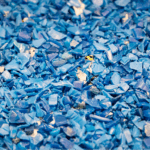Avoiding fossil raw materials is an important step towards a more sustainable future. Recycling plastics is an important route in this respect. The challenge is that recycled raw materials are less consistent in quality, which can lead to problems in production processes that require precision.
An example of this is the production of cable ducts for offices. These ducts consist of two parts that must click together perfectly. Small variations in the composition of the raw material can lead to deviations in the shape of the cable duct parts. This can mean that the duct does not close properly and is therefore unusable.
Researchers Jakob Buist and Tijmen Mateboer from Windesheim University of Applied Sciences received a grant from ChemistryNL to investigate whether ultrasonic vibrations can contribute to a more stable production of plastic products from recycled raw materials.
Ultrasonic vibrations as a game changer
Cable ducts and many other 3D plastic products are produced using extrusion, a production method in which plastic granules are melted and pressed through a die to form a final product. The homogeneity of the melted mass determines the quality of the end result. If the recycled plastic shows too many fluctuations, this can lead to deviations and defective products.
Using a pilot installation, the researchers learned how to use ultrasonic vibrations to keep product quality constant when the composition of the raw materials fluctuates. This means that recycled raw materials can be better used for high-quality applications.
“Of course, there are limits to the technology,” the researchers explain. “If the raw material is too heterogeneous, no vibration can compensate for that. But we now have a good view of the bandwidth and know exactly which vibrations are needed for the best results.”
Added value for companies
The project findings increase the application possibilities of recycled raw materials. Where companies were previously reluctant to use recycled raw materials due to quality problems, they can now opt for sustainable alternatives with more certainty. This not only means cost savings, but also a significant environmental benefit. The industrial project partners will start working on their own production process based on the project results. Jakob Buist: “The plans for a major leap forward are becoming increasingly concrete. I expect that the first products based on our technology will come onto the market in the foreseeable future.”




